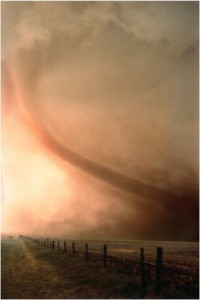Multiple tornadoes struck Oklahoma and Kansas, raining down hailstones the size of baseballs. The storms left more than 65,000 businesses and homes without power. Gas leaks, downed power lines and ground debris have created hazardous conditions in some areas. At least 60 people were injured and emergency officials believe at least two people were killed in the storm. As this is tornado season, it is worth reviewing the safety information about these powerful storms, quoted from pages 94 – 95 of Prepare for the Worst, Plan for the Best: Disaster Preparedness and Recovery for Small Businesses (Wiley, paperback, second edition, 2009):
“Although tornadoes are more common in the Midwestern states, the fact is that they have been reported in each of the 50 states in America and in countries throughout the world. Even if you think you do not live in a tornado- prone area, read this section for the safety information. On April 24, 2007, a tornado tore through Eagle Pass, Texas, causing at least ten fatalities and injuring more than 80 people. Two elementary schools were demolished and almost 300 people were evacuated to shelters. This was an area that is not associated with tornado activity!
Tornadoes are known as “twisters” because tornado winds gust at speeds in excess of 200 miles per hour, destroying everything in their path. Spring and Summer are considered the tornado “seasons,” but they can happen at any time of the year. A tornado watch means that a tornado is possible in your area; a tornado warning means that a tornado has already been sighted. An approaching tornado sounds like a speeding train. Remain indoors, away from the windows that could be shattered by the high-speed winds. If you are in a high-rise building, try to make it to the basement safely. I recommend that you avoid the elevators and take the stairs as fallen power lines could disrupt the supply of electricity to your building without warning. If you don’t have sufficient time to go to the basement or the ground floor, move to the center of the building, which is as far removed from windows on either side of the building as possible. If you are outside, go to the basement of the nearest sturdy building or lie flat in a ditch or a low-lying area. If you are in a car or a mobile home, get out immediately.
As is the case with a hurricane or a flood, remember to bring any equipment that is outside indoors. I have two friends, a husband and wife team, who own and operate a charming inn in New England. The inn caters to vacationing families, and, as such, has outdoor toys, swing sets, picnic tables, barbecues, and other items that could get swept in high winds and cause injuries. Their contingency plan calls for the husband to ensure that the items on the northern and eastern side of the inn are brought indoors when a storm warning is in effect, while the wife is responsible for the lower-weight items on the southern and western side of the inn. By assigning responsibilities, they ensure that nothing will be overlooked.
Once the tornado has passed, check your premises for damage. Be careful when you leave your premises, as fallen power lines pose a particular hazard. Don’t light matches or use candles, as there may be gas leaks of which you are unaware. Listen to the news reports to determine if it is safe to go home and which areas you should avoid on your commute home.”
